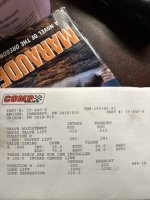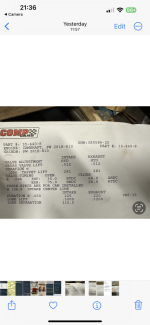Can y’all explain what the lift and duration are in fairly simple terms (as in cam specs for dummies).
In case you were still interested in this info, here’s a little camshaft 101. A very basic 101!
There are several design aspects, but the two most often talked about are lift and duration.
They are quite literally the “bragging rights” of camshaft discussions.
In simplest terms, lift is how far the cam lobe opens the valve, and duration is how long it keeps it open.
Generally, speaking, the more of either/both, the higher the performance, and coming at a higher RPM.
Of course, higher RPM is literally part of the definition of horsepower.
Lift is usually described as either valve lift (the bigger number), or lobe lift (the actual height of the lobe itself).
Lobe lift is the only thing that the cam manufacturer has control of. Their listing of valve lift (in your case .512”) is only an assumption, based on the recommended rocker arm ratio. Some cam cards will list that expected ratio.
If the builder/user decides to install a different rocker arm, the actual valve lift can be different.
If the cam card specifies valve lift, it usually specifies the recommended rocker arm ratio as well.
The cam manufacturer can’t know for sure what the builder installs as a rocker arm, but let’s say for example the typical ratio is 1.5 or 1.6 to 1. The cam manufacturer will say .512 valve lift based on that assumption.
The duration is the number of degrees of rotation that the cam lifts the valve off the valve seat.
I can never remember if that’s cam degrees, or crank degrees, but someone here will know.
But we always have to remember that the cam rotates at half the speed of the crank. This mental note is important when setting ignition timing and other things.
The base circle of the lobe is where no upward motion is put on the lifter. The peak of the lobe (or whatever its proper name is) is where maximum lift is reached. Each of these has its own duration, but it’s not listed. It’s up to each cam manufacturer to decide on the overall profile of the lobe.
Your cam is a single pattern cam, where lift and duration are the same for intake and exhaust. A split pattern cam has more lift and/or duration on the exhaust lobe.
This is to compensate for typically smaller exhaust ports when the cam manufacturer thinks that that particular cylinder had design needs it. And testing in the aftermarket, it’s generally considered a slightly higher performance in most situations to have a split pattern cam.
The adjustment section will list how much clearance is recommended at the valve stem tip and rocker arm interface. Measured in thousandths of an inch
That would be on adjustable valvetrain. Yours simply says HYD (for hydraulic), but that is not all the story.
Some hydraulic lifter setups are adjustable, while some are not. They leave that up to you and the installer and the manufacturer of the cylinder heads.
Regarding the bits that say “at .006“ or “at .050“ are because in the old days there was no standardization for measuring.
The .006 is duration (the larger duration number) their way of rating their overall lift, when the valve just starts to open. The .050 rating was brought up, probably in the aftermarket, to reduce the fudge factor when comparing cams from one manufacturer to another.
What they’re talking about is not measuring the duration of the event, until the valve has reached .050 inch off the seat.
This gives some consistency that is otherwise not always available because lobe patterns can very radically from one to another.
And speaking of varying erratically, a flat-tappet lobe ramp profile is limited based on performance and reliability/longevity. A roller cam ramp profile can be much more radical, because the cam follower/lifter’s roller base has the ability to follow a steeper profile. The sharp edge of a lifter flat-tappet lifter can’t do that.
That’s about all I’ve got for now! A lot of basic cam stuff in there, but hopefully you can glean some useful information from it.












